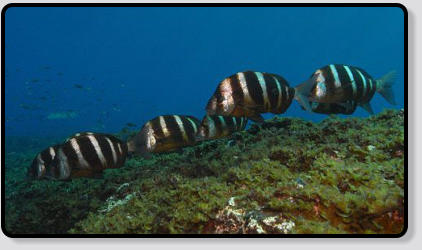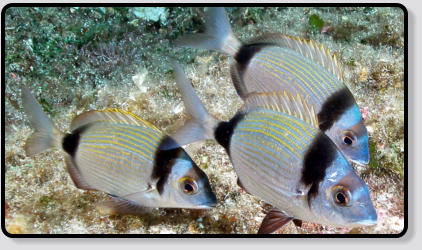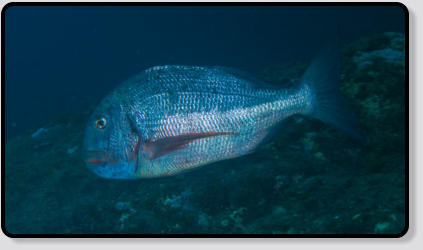Scientific classification
Kingdom:
Phylum:
Chordata
Class:
Actinopterygii
Order:
Perciformes
Family:
Sparidae
Genus:
Diplodus
Species:
D. Sargus
Binomial name (link Wikipedia)




White Bream
Sar Commun
Geibbrasse
Sargo Blanco
Zesband Zeebrasem

Description
Length: up to 45cm / Habitat: Rocky bottoms.
Diplodus sargus, called White seabream and Sargo, is a species of seabream native to the eastern Atlantic and western Indian Oceans. It is
found from the Bay of Biscay southwards to South Africa, including Madeira and the Canary Islands, the Mediterranean and (rarely) the Black
Sea. Occasionally individuals are found off the Indian Ocean coasts of South Africa, Mozambique and Madagascar, and they are very rarely
found elsewhere in the Indian Ocean, such as off Oman. An active fish, they inhabit the surf zone, but they may be found down to 50 m.
They consume small crustaceans, mollusks and some seaweed and coral, using their strong jaws to crush shells. Individuals can reach 45 cm,
but average 22 cm.
Diplodus sargus are protandrous hermaphrodites, with individuals starting out life as males, and some becoming female later on.
It is commercially fished, with 3,713 t taken in 2008. Some are reared using aquacultural techniques. The catch is eaten immediately or marketed
locally, as the flesh tastes good only when fresh.

Animalia
Scientific classification
Kingdom:
Phylum:
Chordata
Class:
Actinopterygii
Order:
Perciformes
Family:
Sparidae
Genus:
Diplodus
Species:
D. Puntazzo
Binomial name (link Wikipedia)




Sharp-Snout Sea Bream
Sar À Museau Pointu
Spitzbrasse
Sargo Picudo
Spitssnuit Zeebrasem

Description
Length: up to 45 cm / Habitat: Rocky and rocky/sandy bottoms.
No further information available on Wikipedia.
Animalia
Scientific classification
Kingdom:
Phylum:
Chordata
Class:
Actinopterygii
Order:
Perciformes
Family:
Sparidae
Genus:
Diplodus
Species:
D. Cervinus
Binomial name (link Wikipedia)




Zebra Bream
Sar Impérial
Bänderbrasse
Sargo Breado
Zebra Zeebrasem

Description
Length: up to 50 cm / Habitat: Rocky Bottoms.
The zebra seabream has a high compressed laterally body with a pointed snout and thick lips.It is a medium-sized fish which can reach a
maximum length of 55 cm, with an average length of 35 cm. Its background color is silvered with dark vertical bands, the first five ones run
across the body from the caudal peduncle to the pectoral fins level, another characteristic dark band cross the space between the eyes while
crossing them.
Diplodus cervinus is found in eastern Atlantic Ocean from Gulf of Biscay to South Africa and also in Mediterranean Sea. Youth, it prefers shallow
and quiet living areas like rocks, piers and grass beds. Adult, it usually lives rocky slopes and wrecks.
No further information available on Wikipedia.
Animalia
Scientific classification
Kingdom:
Phylum:
Chordata
Class:
Actinopterygii
Order:
Perciformes
Family:
Sparidae
Genus:
Diplodus
Species:
D. Vulgaris
Binomial name (link Wikipedia)




Two-Banded Bream
Sar À Tête Noire
Zweibindenbrassen
Seifía
Zwartkopzeebrasem

Length: up to 30 cm / Habitat: Rocky and sandy bottoms with sea grass meadows.
Diplodus vulgaris can reach a length of about 45 centimetres (18 in) with maximum recorded weight of 1.3 kilograms (2.9 lb). Body is generally
grey-silver, with two well-defined vertical black bands, one close to the gills and one in the rear of the body, just before the base of the caudal fin.
Another black stripe, less pronounced, is present near the eyes. There are golden lines along the body, typically on the back.
Lips are rather thick. In each jaw, there are 8 narrow, light-brownish incisors. In the western Mediterranean, it reproduces in October and
November and in the eastern Mediterranean in December and January.
It is a gregarious species, sometimes forming groups composed even by many specimens. In the shallows, it often creates smaller groups even
with other similar species. Adults feed on benthic invertebrates, crustaceans, worms and mollusks.
This species is widespread in the Mediterranean Sea, in the Black Sea and in the Eastern Atlantic Ocean, at depths of 0 to 160 m, more
commonly between 0 and 30 m.
It inhabits rocky, sandy bottoms and seagrass beds. On sandy bottoms, it can be often found following species that dig the sand and trying to
steal their food.
Description
Animalia
Scientific classification
Kingdom:
Phylum:
Chordata
Class:
Actinopterygii
Order:
Perciformes
Family:
Sparidae
Genus:
Pagrus
Species:
P. Pagrus
Binomial name (link Wikipedia)




Common Bream
Pagre Commun
Sackbrasse
Bocinegro
Gewone Zeebrasem

Length: up to 60 cm / Habitat: Rocky and rocky/sandy bottoms.
The red porgy (Pagrus pagrus), or common seabream, is a species of fish in the family Sparidae. It is found in a wide variety of locations that
range from Europe to the Caribbean. Also known along the Gulf Coast as White Snapper, even though it is not a true Snapper.
No further information available on Wikipedia.
Description
Animalia
Scientific classification
Kingdom:
Phylum:
Chordata
Class:
Actinopterygii
Order:
Perciformes
Family:
Sparidae
Genus:
Pagrus
Species:
P. Augriga
Binomial name (link Wikipedia)




Red-Banded Bream
Pagre Rayé
Rotbandbrasse
Sama Roquera
Rood-gestreepte Zeebrasem

Length: up to 60 cm / Habitat: Rocky and rocky/sandy bottoms.
No further information available on Wikipedia.
Description
Animalia





Harry van Goor 2016
source: Wikipedia, the free encyclopedia


Categories: Sea Breams
Scientific classification
Kingdom:
Phylum:
Chordata
Class:
Actinopterygii
Order:
Perciformes
Family:
Sparidae
Genus:
Dentex
Species:
D. Gibbosus
Binomial name (link Wikipedia)




Pink Dentex
Denté Rose
Dickkopf-Zahnbrasse
Pargo
Rose Zeebrasem

Length: up to 1 metre / Habitat: Rocky bottoms (bare rock) and rocky/sandy bottoms.
No further information available on Wikipedia.
Description
Animalia

Scientific classification
Kingdom:
Phylum:
Chordata
Class:
Actinopterygii
Order:
Perciformes
Family:
Sparidae
Genus:
Oblada
Species:
O. Melanura
Binomial name (link Wikipedia)




Saddled Bream
Oblade
Brandbrasse
Galana
Zadel Zeebrasem

Length: up to 30 cm / Habitat: Rocky bottoms and sea grass meadow.
It has a fuse-shaped blueish-silver body, with a black spot near the tail. The maximum length recorded for this species is 34 centimetres (13 in),
and maximum recorded weight is 0.6 kilograms (1.3 lb). Commonly specimens are around 20 centimetres (7.9 in). The mouth is relatively small,
with lower jaw being little bit in front of the upper jaw.
It is a gregarious fish, spawning in June and July. The saddled seabream is an omnivorous fish, but feeds mainly on small invertebrates.
It is found over seagrass and rocky bottoms in the Mediterranean Sea, Bay of Biscay, Madeira, Cape Verde, Canary Islands and Strait of
Gibraltar to Angola.
It can be found between 0 and 30m, but more commonly between 5 and 20m. Often can be found near surface, not far away from the shore.
Description
Animalia

Scientific classification
Kingdom:
Phylum:
Chordata
Class:
Actinopterygii
Order:
Perciformes
Family:
Sparidae
Genus:
Sarpa
Species:
S. Salpa
Binomial name (link Wikipedia)




Cow Bream
Saupe
Goldstrieme
Salema
Gestrepte Bokvis

Length: Average size 25 cm / Habitat: Rocky bottoms with seaweed.
Sarpa salpa, known commonly as the salema, salema porgy, cow bream or goldline, is a species of sea bream, recognisable by the golden
stripes that run down the length of its body, and which can cause hallucinations when eaten. It is found in the East Atlantic, as well as the
Mediterranean, where it ranges from the Bay of Biscay to South Africa. It has occasionally been found as far north as Great Britain. It is generally
common and found from near the surface to a depth of 70 m (230 ft). Males are typically 15 to 30 cm (6–12 in) in length, while females are
usually 31 to 45 cm (12–18 in). The maximum size is 51 cm (20 in).
No further information available on Wikipedia.
Description
Animalia

Scientific classification
Kingdom:
Phylum:
Chordata
Class:
Actinopterygii
Order:
Perciformes
Family:
Sparidae
Genus:
Lithognathus
Species:
L. Mormyrus
Binomial name (link Wikipedia)




Striped Bream
Marbré
Marmorbrasse
Herrera
Zandsteen Baars

Length: Average size 25 cm / Habitat: Rocky bottoms and sea grass meadow.
The sand steenbras or striped seabream (Lithognathus mormyrus) is a species of marine fish in the family Sparidae. It is found in shallow water
in the Mediterranean Sea and in the eastern Atlantic Ocean from France to South Africa. It also occurs in the Red Sea and off the coast of
Mozambique in the Indian Ocean.
The sand steenbras is a moderately deep-bodied fish that can grow to a length of about 55 cm (22 in), with a weight of around 1 kg (2.2 lbs), but
a more common size is 30 cm (12 in). Its head is about as long as it is high and its upper profile is slightly convex. The dorsal fin has eleven
spines and twelve to thirteen soft rays. The pectoral fin is shorter than the head and has fifteen to seventeen soft rays. The anal fin has three
spines and ten to eleven soft rays. The head and body are silver, the body being marked with about fourteen vertical dark bands
Description
Animalia

Scientific classification
Kingdom:
Phylum:
Chordata
Class:
Actinopterygii
Order:
Perciformes
Family:
Sparidae
Genus:
Boops
Species:
B. Boops
Binomial name (link Wikipedia)




Bogue
Bogue
Gelbstriemen
Boga
Bokvis

Length: Average size 15 cm / Habitat: coastal pelagic.
Boops boops (literally "cow-eye"), also called the bogue, is a species of seabream native to the eastern Atlantic. Its common name in all
languages refers to its large ("bug") eyes. It is found off the coasts of Europe, Africa, the Azores and the Canary Islands, from Norway to Angola,
and in the Mediterranean and Black Seas. The species avoids brackish waters such as the Baltic Sea. A demersal and semi-pelagic feeder, it can
generally be found down to 100 m, and infrequently down to 350 m. It consumes seaweed, crustaceans, and some plankton, in schools that rise
to the surface at night. Individuals can reach 36 cm, but average 20 cm.
Sex determination in Boops boops is unclear. It has variously been described as a rudimentary intersex organism, with a few intersex individuals,
or a protogynic intersex, with individuals starting out life as females, and some becoming male later on.
Description
Animalia

Scientific classification
Kingdom:
Phylum:
Chordata
Class:
Actinopterygii
Order:
Perciformes
Family:
Sparidae
Genus:
Spondyliosoma
Species:
S. Cantharus
Binomial name (link Wikipedia)




Black Bream
Criset
Streifenbrasse
Chopa
Zeekarper

Length: Average size 25 cm / Habitat: Rocky bottoms (bare rock) and rocky/sandy bottoms.
The black seabream (Spondyliosoma cantharus) is a species of Sparidae fishes. They are recognisable by their oval compressed body and jaws
containing 4-6 rows of slender teeth which are larger at the front. They are silvery in colour with blue and pink tinges and broken longitudinal gold
lines. They can reach a maximum size of 60 cm in length. They live in northern Europe and in the Mediterranean, usually found on the inshore
shelf at depths varying from 5 to 300 m. They are usually found in schools feeding on seaweeds and invertebrates. They breed in February to
May leaving eggs in the demersal zone.
Black seabream are protogynous meaning females have the ability to change to males.
Description
Animalia












